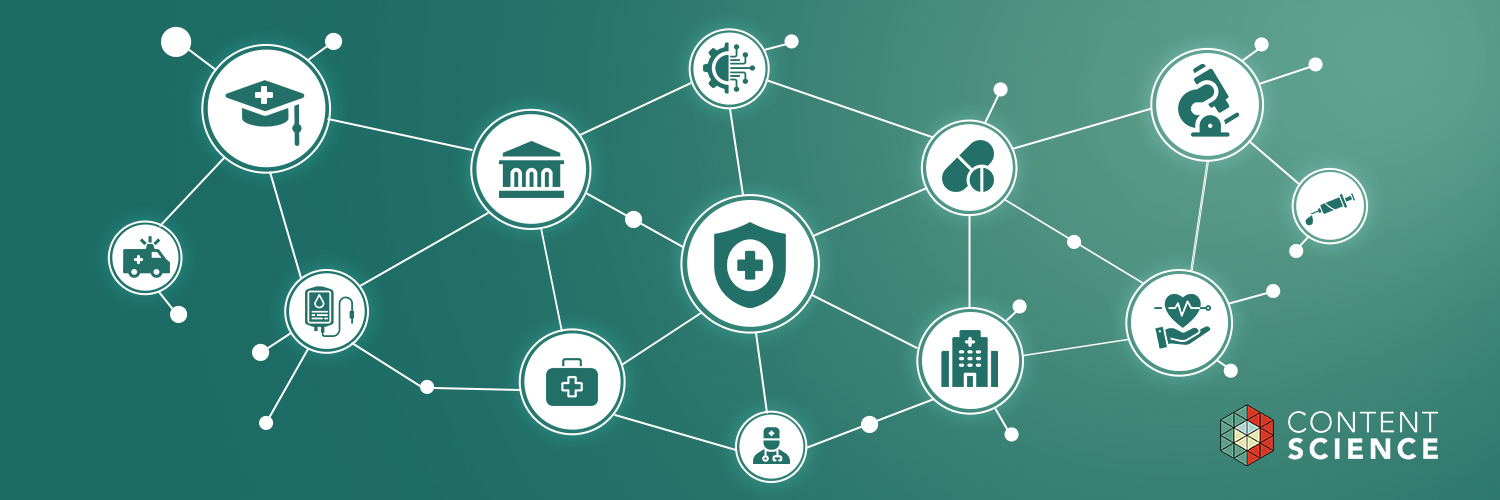
The pandemic pushed the health ecosystem in the U.S. to the brink. Hospitals couldn’t care for all of the patients. Researchers couldn’t easily communicate with each other about what was happening. And, people couldn’t get high-quality, reliable information quickly.
Three years later, a lot has changed. We now have vaccines, treatments, and much more information about COVID. But is our health ecosystem ready for the next pandemic?
Chris Jones, PhD, is an expert in how health ecosystems work, and he thinks there’s reason to be optimistic. Jones spent 12 years at the Centers for Disease Control and Prevention (CDC), where he most recently served as the Director for Performance and Evaluation Office. Jones recently joined Content Science as Vice President to sustain and accelerate scale.
In this interview, Jones discusses the state of the health ecosystem, the vital role of content, and how we can address misinformation and disinformation.
You spent many years leading initiatives at the CDC, including during the pandemic. How do you see the state of the health ecosystem?
The past few years have stressed the health ecosystem. But that stress has led to innovations, accelerated information and data production, and increased awareness of health inequities.
We have seen the value and importance of collaboration across academia, the public sector, and private sector industries. As we’re coming to the other side of the pandemic, we are looking for ways to advance the health system, innovate, and build a robust system for data sharing to inform decision making.
We’re still struggling with information management and the quality of information, especially with the challenges of misinformation and disinformation. We also are struggling with really effective knowledge translation – the application of knowledge to accelerate what’s being learned through research to improve health and identify effective services and products to strengthen health systems. We still have a lot of gaps and a lot of opportunities to improve how we generate accurate information in an efficient and timely way, and present it in a way that people can digest it and know what to do with it.
Having worked throughout the health ecosystem, including with federal and state government agencies, medical associations, educational institutions, pharmacies, insurers, and health solutions, what do you think are the most exciting opportunities to innovate and modernize across this ecosystem?
There are a lot of opportunities around partnerships and collaboration across the health ecosystem. And that’s really exciting for the potential of developing new treatments, technology, research, and for making advances in health communication.
We saw a lot of fruitful work and innovations come out of the last several years. For example, the advances in the speed of developing effective treatments, generating evidence about effective interventions, and the translation of that evidence into actionable information for people to use to make decisions.
Data linkages and system interoperability is another big opportunity. This is an opportunity for improving our efficiency and effectiveness of understanding what’s happening in our health ecosystem, when there are risks, and how interventions are working. We saw improvement during the pandemic of rapid data production and more system linkages. Innovative partnerships emerged across academia, government, and the private sector to support initiatives of layering data to understand community-level interventions. This type of work helped us get closer to real-time information about how the interventions were impacting the spread of the virus, how the interventions were being used, and any unintended consequences related to those interventions.
What is the role of content in the health ecosystem, particularly as it modernizes?
Content is a central part of the health ecosystem. From technical documentation on how health system organizations do their work or how they communicate with each other, to generating evidence from research, or translating complex findings into useful simple information, content is key. Content is an essential to the effective growth and maintenance of health systems and how the health system interacts with communities within the ecosystem.
Content has a role in influencing and shaping knowledge, attitudes, and behaviors. Accurate and concise content helps communities understand how to interact with their health ecosystem. We saw that during COVID-19, with dense information or content or delayed content about managing COVID-19, people didn’t have what they needed to inform their decisions. And when there’s a void, people will go elsewhere for that information, or they’ll drift back to their biases.
We also saw an added complication with the pandemic, changing information because the data and evidence gave us new knowledge. Remember the early days of COVID-19, when everyone was worried about getting it from surfaces? It was nearly impossible to find hand sanitizer, wipes, and other cleaning products. Then we learned that COVID-19 was actually spreading through the air, making hand sanitizer not as important as masks. Content can help communicate change and what it means for our decisions.
Each of us probably has our own algorithm when we’re trying to decide which websites we go to for health information. And they’re probably sites that have had reliable information before, have credentials that make us comfortable, and give us information in a way that we can digest it.
Could you share an example of a successful collaboration you have had in the health space that highlights the value of public and private health organizations working together?
One of the most rewarding collaborations I worked on was at the Division for Heart Disease and Stroke Prevention. The project spanned the process of developing evidence, turning that evidence into useful information, and then seeing the evidence used in practice. The collaboration was across academia, federal government, state government, professional organizations, and healthcare systems.
CDC collaborated with the Community Guide and the Community Preventive Services Task Force on a systematic review focused on tailored pharmacy-based interventions. The review found that these interventions were effective at improving medication adherence for cardiovascular disease and that the interventions were cost effective. CDC used these findings to develop actionable guides and tools in collaboration with academia and professional organizations from health care, including physicians, pharmacists, and nurse practitioners. The resources developed provided state health departments and health care professionals with steps to use and examples of how to implement the tailored interventions. CDC incorporated these strategies into funding to state health departments and the guidance was applied in the field, through collaborations across government, health systems, and local pharmacy organizations. There’s a great example in Michigan of how the health system, university, and government all worked together to help advance the pharmacist patient care process. It was really exciting to see the enthusiasm and willingness for collaboration across partners!
We saw similar collaborations across health care, health systems, and government during COVID. Physicians, pharmacists, and health care systems worked together under expanded authorities to make sure vaccines could get out in as many ways as possible. The collaboration and flexibility of scopes of practice helped expand vaccination access at a critical time.
Misinformation and disinformation have become significant problems, especially in the health space. What do you think can be done?
Careful and efficient curation of evidence is essential. It’s also important to recognize how information and content influence knowledge, attitudes, and behaviors.
There’s opportunity for partnerships across government, industry, and healthcare to curb the impact of misinformation and disinformation. Close collaboration across these sectors can help ensure the information being shared is visible, easy to discover, consistent, and credible. The complexity of the information should be tailored to a variety of audiences in the community. It is important to provide access to accurate, reliable health information across a variety of mediums and channels so that it’s useful across different communities. The Public Health Communications Collaborative is a public health partnership developed during the COVID-19 pandemic and continues to develop resources for public health communications.
There’s a lot of opportunity for innovative technologies like artificial intelligence (AI) to be a part of the equation. We do have to recognize both the benefits and risks. Leveraging the benefits of AI will be an important part of the solution. For example, there’s much potential for AI to accelerate the timely and efficient curation of evidence.
You’re shifting from the CDC to a new role at Content Science. Why are you making this change at this time?
I’ve always been passionate about evidence. When I worked in behavioral health, I was trained in evidence-based interventions, practiced those interventions in the field, and studied adaptations to those interventions. I became really interested in understanding whether or not strategies worked, how to adapt to new challenges, and how to continuously improve based on what was learned through implementation.
And as I shifted to CDC and focused on public health evaluation and applied research, I contributed program development and improvement, the generation of evidence, and translation of evidence into best practices and resources for public health and public health professionals. It was very exciting to be a part of large scale efforts across different public health topic areas, and participate in organizational development and improvement.
Over recent years, I’ve seen the importance of and opportunities for improving the translation of information in a timely, efficient, and useful way to help people make decisions. I’m really excited to join Content Science and continue my pursuit of using evidence to inform decision making. I’m thrilled that Content Science is a firm that’s grounded in communication science and methodology. I’m energized by the opportunity to contribute to the firm’s dedication to content science and to expand their footprint in health-focused solutions.
The past few years have stressed the health ecosystem. But that stress has led to innovations, accelerated information and data production, and increased awareness of health inequities.
-
Events, Resources, + More
The Ultimate Guide to End-to-End Content
Discover why + how an end-to-end approach is critical in the age of AI with this comprehensive white paper.
The Content Advantage Book
The much-anticipated third edition of the highly rated book by Colleen Jones is available at book retailers worldwide. Learn more!
20 Signs of a Content Problem in a High-Stakes Initiative
Use this white paper to diagnose the problem so you can achieve the right solution faster.
Upskill with Content Science Academy
Training for modern content roles through on-demand certifications + courses or live workshops.







Comments
We invite you to share your perspective in a constructive way. To comment, please sign in or register. Our moderating team will review all comments and may edit them for clarity. Our team also may delete comments that are off-topic or disrespectful. All postings become the property of
Content Science Review.